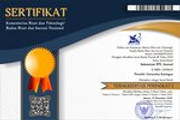APPLICATION DEVELOPMENT OF AUGMENTED REALITY FOR ELEMENTARY ENGLISH TEACHING
Abstract
When children learn English, they have a limited capacity for long-term attention, which necessitates learning English to be more creative, interactive, and innovative. Furthermore, smartphone technology provides these advantages, one of which is the augmented reality application, a novel issue in English teaching. The purpose of this research is to explain how to design Augmented Reality applications. The research design is the multimedia development life cycle (MDLC), and the research method is descriptive qualitative. It was explained that the augmented reality application could be used with the image distance and the augmented display up to 30 cm and that it could be used by teachers without the assistance of a computer technician using the six cycles of MDLC: concept, design, collecting material, assembly, testing, and distribution. The findings show that Augmented Reality can be used as a creative, interactive, and innovative media to help students learn English.
Keywords: Augmented Reality; elementary school; English teaching process.
Full Text:
PDFReferences
Arunsirot, N. (2020). Implementing the augmented reality technology to enhance English pronunciation of Thai EFL students. KKU Research Journal (Graduate Studies) Humanities, 8(3), 142-153. https://so04.tci- thaijo.org/index.php/gskkuhs/article/view/247821
Chatzopoulos, D. (2017). Mobile Augmented Reality survey: From where we are to where we go. In IEEE Access (Vol. 5, pp. 6917–6950). https://doi.org/10.1109/ACCESS.2017.2698164
Dou, Q. (2021). Multimodal discourse analysis in the blended teaching of college English flipped class. Journal of Electrical Engineering & Education. https://doi.org/10.1177/00207209211004212
Fonseca, D., Martí, N., Redondo, E., Navarro, I., & Sánchez, A. (2014). Relationship between student profile, tool use, participation, and academic performance with the use of Augmented Reality technology for visualized architecture models. Computers in Human Behavior, 31(1), 434–445. https://doi.org/10.1016/j.chb.2013.03.006
Hsieh, M. C., & Chen, S. H. (2019). Intelligence augmented reality tutoring system for mathematics teaching and learning. Journal of Internet Technology, 20(5), 1673-1681. https://jit.ndhu.edu.tw/article/view/2148
Hussain, Z. (2021). Effectiveness of virtual and augmented reality for improving knowledge and skills in medical students: Protocol for a systematic review. In BMJ Open (Vol. 11, Issue 8). https://doi.org/10.1136/bmjopen-2020-047004
Jamrus, M. H. M., & Razali, A. B. (2021). Acceptance, readiness and intention to use Augmented Reality (AR) in teaching English Reading among secondary school teachers in Malaysia. Journal of University Education, 17(4), 312-326. https://myjms.mohe.gov.my/index.php/AJUE/articl e/view/16200
Jing, X., & Jing, W. (2018). An empirical study of mobile learning in promoting English vocabulary teaching in multimodal environment. 2019 Asia-Pacific Conference on Education, Philosophy, Management and Business (ACEPMB 2019). Francis Academic Press. https://webofproceedings.org/proceedings_series/ESSP/ACEPMB 2019/EEMB01.pdf
Karagozlu, D., & Ozdamli, F. (2017). Student opinions on mobile augmented reality application and developed content in science class. TEM Journal. https://www.ceeol.com/search/article- detail?id=588939
Kirikkaya, E., & Basgul, M. (2019). The effect of the use of augmented reality applications on the academic success and motivation of 7th grade students. Journal of Baltic Science Education, 18(3), 362-378.
Liu, F., Du, J., Zhou, D. Q., & Huang, B. (2021). Exploiting the potential of peer feedback: The combined use of face-to-face feedback and e- feedback in doctoral writing groups. Assessing Writing, 47(August), 100482. https://doi.org/10.1016/j.asw.2020.100482
Madanipour, P., & Cohrssen, C. (2020). Augmented reality as a form of digital technology in early childhood education. Journal of Early Childhood, 45(1), 1836939119885311. https://doi.org/10.1177/1836939119885311
Oranç, C., & Küntay, A. C. (2019). Learning from the real and the virtual worlds: Educational use of augmented reality in early childhood. International Journal of Child-Computer Interaction, 21, 104-111. https://www.sciencedirect.com/science/article/pii/ S221286891830028X
Parmaxi, A., & Demetriou, A. A. (2020). Augmented reality in language learning: A state‐of‐the‐art review of 2014–2019. Journal of Computer Assisted …. https://doi.org/10.1111/jcal.12486
Rodríguez-Vizzuett, L. (2019). An augmented reality- based application relying on the use of tangible user interfaces for english teaching to children between 10 and 12 years. In Communications in Computer and Information Science (Vol. 1114, pp. 97–112). https://doi.org/10.1007/978-3-030- 37386-3_8
Sudirman, S., Yaniawati, R. P., Melawaty, M., & Indrawan, R. (2020). Integrating ethnomathematics into augmented reality technology: Exploration, design, and implementation in geometry learning. Journal of Physics Conference Series, 1521(3), 032006. https://doi.org/10.1088/1742- 6596/1521/3/032006
Tzima, S., Styliaras, G., & Bassounas, A. (2019). Augmented reality applications in education: Teachers point of view. Education Sciences, 9(2), 1-18. https://doi.org/10.3390/educsci9020099
Xue, Y., & Wang, J. (2021). English listening teaching device and method based on virtual reality technology under wireless sensor network environment. Journal of Sensors, 8261861. https://www.hindawi.com/journals/js/2021/82618 61/
Yen, J.-C., Tsai, C.-H., & Wu, M. (2013). Augmented reality in the higher education: Students’ science concept learning and academic achievement in astronomy. Procedia - Social and Behavioral Sciences, 103, 165–173. https://doi.org/10.1016/j.sbspro.2013.10.322
Yim, M. (2017). Is augmented reality technology an effective tool for e-commerce? An interactivity and vividness perspective. Journal of Interactive Marketing, 39, 89–103. https://doi.org/10.1016/j.intmar.2017.04.001
Zainuddin, N., Sahrir, M. S., Idrus, R. M., & Jaffar, M. N. (2016). Scaffolding a conceptual support for personalized Arabbic vocabulary learning using augmented reality (AR) enhanced flashcards. Journal of Personalized Learning, 2(1), 95-103.
DOI: https://doi.org/10.25134/ieflj.v9i1.6423
Refbacks
- There are currently no refbacks.

This work is licensed under a Creative Commons Attribution-ShareAlike 4.0 International License.

